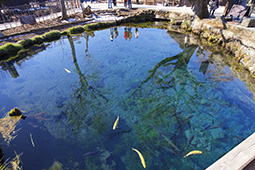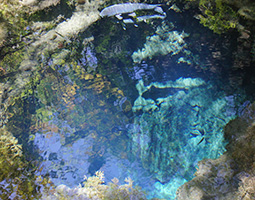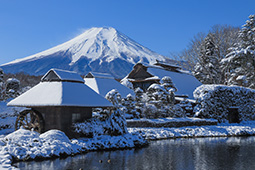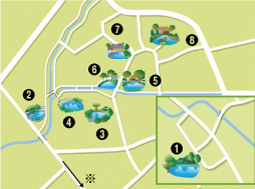January 2023
- English
- 日本語
Oshino Hakkai: Eight World Heritage Ponds

Shobu Pond (Iris Pond) (map❽) 
Choshi Pond (Sake Server Pond) (map❹)

Kagami Pond (Mirror Pond) (map❼) 
Waku Pond (Spring Pond) (map❺) 
Okama Pond (Pot Pond) (map❷) 
A visitor learns how to make Ainu embroidery at the ikar usi workshop in the National Ainu Park 
Map of Oshino Hakkai; ❶Deguchi Pond; ※Deguchi Pond (10 min. walk); ❷Okama Pond; ❸Sokonashi Pond; ❹Choshi Pond; ❺Waku Pond; ❻Nigori Pond; ❼Kagami Pond; ❽Shobu Pond

The eight ponds that make up Oshino Hakkai, a component part of the “Fujisan” World Heritage site and known as an unspoiled landscape of Japan, owe their beauty to water that travels underground from Mt Fuji.

Oshino in Yamanashi Prefecture is a small village with a population of about 9,700 situated in the northeastern foothills of Mt. Fuji. In the village there are eight ponds, known as Oshino Hakkai (literally, Eight Seas of Oshino), that are filled with clear underground water originating from Mt. Fuji. The spring water from these ponds has been used for drinking, domestic use, agriculture, and more by local people since ancient times.

Oshino Hakkai was designated by the Japanese government as a Natural Monument in 1934 and selected by the present Ministry of Environment as one of the 100 Best Water Sources of Japan in 1985. All of the ponds are component parts of the “Fujisan, sacred place and source of artistic inspiration” World Heritage site. The ponds are named: Deguchi Pond (Exit Pond), Okama Pond (Pot Pond), Sokonashi Pond (Bottomless Pond), Choshi Pond (Sake Server Pond), Waku Pond (Spring Pond), Nigori Pond (Unclear Pond), Kagami Pond (Mirror Pond), and Shobu Pond (Iris Pond).

In addition to supporting the daily life of the local people, Oshino Hakkai is also linked to worship of Mt. Fuji. It is said for example that practitioners of the Fuji-ko faith (see here) came to Oshino Hakkai to bathe in the water of the ponds to purify their minds and bodies before climbing Mt. Fuji. Each pond also has its own legend. For example, it is said that the waters of Kagami Pond have the spiritual ability to discern right from wrong, and in the past, when there was trouble between locals, both parties would bathe in the waters of the ponds and pray for a resolution to the dispute.

Hinishi Osamu, a guide at the Oshino Tourist Information Center, explains the origins of Oshino Hakkai. “A lot of rain and snow falls on Mt. Fuji, but not a single river flows on the mountain itself. The surface of the mountain is covered in volcanic sediment and lava rocks which water easily penetrates, and so precipitation soaks into the ground once it falls. The spring water from Mt. Fuji has been filtered over a long period of time through an underground permeable layer and eventually springs up to the surface here and there at the base of the mountain. Oshino Hakkai is one of those places, and analysis has revealed that the water that wells up here is the water from rain and melted snow that fell on Mt. Fuji more than 20 years ago.”

Visitors to Oshino Hakkai are first surprised by how transparent the water is. As it is possible to see clearly all the way to the bottom of the deep ponds, the various species of fish that are carefully raised and protected by the local people swim in the water as if floating in air.
Hinishi says, “The water springing up at Oshino Hakkai flows down through Kanagawa Prefecture and into the Pacific Ocean. Along the way, there was an intake point known as the Yokohama Aqueduct, the first modern water channel in Japan which began supplying water in 1887. It is said that the water supplied by the aqueduct to Yokohama Port was praised for its purity by sailors at port at that time and had the reputation of ‘not going bad even if it were to be carried across the equator.’”

Around the Oshino Hakkai ponds filled with clear water and the streams flowing from those ponds, traditional Japanese houses dot the landscape. In the background, Mt. Fuji rises up from its large, symmetrical base. This sight, said to be a view of Japan unspoiled for several hundred years, continues to attract travelers from within Japan and abroad.

